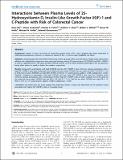| dc.contributor.author | Wu, Kana | |
| dc.contributor.author | Feskanich, Diane | |
| dc.contributor.author | Fuchs, Charles Stewart | |
| dc.contributor.author | Chan, Andrew Tan | |
| dc.contributor.author | Willett, Walter C. | |
| dc.contributor.author | Hollis, Bruce W. | |
| dc.contributor.author | Pollak, Michael N. | |
| dc.contributor.author | Giovannucci, Edward L. | |
| dc.date.accessioned | 2012-08-08T14:03:49Z | |
| dc.date.issued | 2011 | |
| dc.identifier.citation | Wu, Kana, Diane Feskanich, Charles S. Fuchs, Andrew T. Chan, Walter C. Willett, Bruce W. Hollis, Michael N. Pollak, and Edward Giovannucci. 2011. Interactions between plasma levels of 25-hydroxyvitamin D, insulin-like growth factor (IGF)-1 and C-peptide with risk of colorectal cancer. PLoS ONE 6(12): e28520. | en_US |
| dc.identifier.issn | 1932-6203 | en_US |
| dc.identifier.uri | http://nrs.harvard.edu/urn-3:HUL.InstRepos:9369413 | |
| dc.description.abstract | Background: Vitamin D status and levels of insulin-like growth factor (IGF)-1 and C-peptide have been implicated in colorectal carcinogenesis. However, in contrast to vitamin D IGF-1 is not an easily modifiable risk factor. Methods: Combining data from the Health Professionals Follow up Study (HPFS) and the Nurses' Health Study cohort (NHS) additive and multiplicative interactions were examined between plasma 25-hydroxyvitamin D (25(OH)D) and IGF-1, IGFBP-3 as well as C-peptide levels in 499 cases and 992 matched controls. For the various analytes, being high or low was based on being either above (or equal) or below the medians, respectively. Results: Compared to participants with high 25(OH)D and low IGF-1/IGFBP-3 ratio (reference group), participants with a high IGF-1/IGFBP-3 ratio were at elevated risk of colorectal cancer when 25(OH)D was low (odds ratio (OR): 2.05 (95% CI: 1.43 to 2.92), but not when 25(OH)D was high (OR:1.20 (95% CI: 0.84 to 1.71, p(interaction): additive = 0.06, multiplicative = 0.25). Similarly, compared to participants with high 25(OH)D and low molar IGF-1/IGFBP-3 ratio and low C-peptide levels (reference group), participants with a combination of either high IGF-1/IGFBP-3 ratio or high C-peptide were at elevated risk for colorectal cancer when 25(OH)D was low (OR = 1.90, 95% CI: 1.22 to 2.94) but not when 25(OH)D was high (OR = 1.15, 95% CI: 0.74 to 1.77, p(interaction): additive = 0.004; multiplicative = 0.04). Conclusion: The results from this study suggest that improving vitamin D status may help lower risk of colorectal cancer associated with higher IGF-1/IGFBP-3 ratio or C-peptide levels. | en_US |
| dc.language.iso | en_US | en_US |
| dc.publisher | Public Library of Science | en_US |
| dc.relation.isversionof | doi:10.1371/journal.pone.0028520 | en_US |
| dc.relation.hasversion | http://www.ncbi.nlm.nih.gov/pmc/articles/PMC3247212/pdf/ | en_US |
| dash.license | LAA | |
| dc.subject | biology | en_US |
| dc.subject | anatomy and physiology | en_US |
| dc.subject | endocrine system | en_US |
| dc.subject | endocrine physiology | en_US |
| dc.subject | insulin-like growth factor | en_US |
| dc.subject | endocrinology | en_US |
| dc.subject | epidemiology | en_US |
| dc.subject | nutrition | en_US |
| dc.subject | vitamins | en_US |
| dc.subject | oncology | en_US |
| dc.subject | cancers and neoplasms | en_US |
| dc.subject | gastrointestinal tumors | en_US |
| dc.subject | colon adenocarcinoma | en_US |
| dc.title | Interactions between Plasma Levels of 25-Hydroxyvitamin D, Insulin-Like Growth Factor (IGF)-1 and C-Peptide with Risk of Colorectal Cancer | en_US |
| dc.type | Journal Article | en_US |
| dc.description.version | Version of Record | en_US |
| dc.relation.journal | PLoS ONE | en_US |
| dash.depositing.author | Feskanich, Diane | |
| dc.date.available | 2012-08-08T14:03:49Z | |
| dc.identifier.doi | 10.1371/journal.pone.0028520 | * |
| dash.contributor.affiliated | Fuchs, Charles | |
| dash.contributor.affiliated | Wu, Kana | |
| dash.contributor.affiliated | Giovannucci, Edward | |
| dash.contributor.affiliated | Feskanich, Diane | |
| dash.contributor.affiliated | Chan, Andrew | |
| dash.contributor.affiliated | Willett, Walter | |


